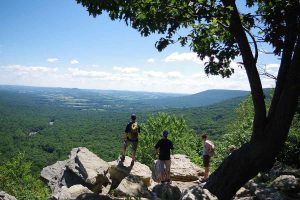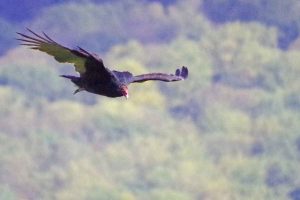The trail we walked was ancient, or at least much older than the intentions of those traveling it this day.
Times, attitudes, change.
We started with a gentle climb. Leaving the Hawk Mountain Sanctuary Association visitor center near Kempton, Pa., at our back, we crossed the road and passed through a gate, manned by a friendly steward who handed us a map and sent us on our way.
The trail was busy, even then, on a hot summer day, but not crowded like it is sure to be now. It wound through the woods, always uphill. The going was gentle at first, then increasingly steep and bony.

Hawk watching is best along ridges with the proper currents.
Bob Frye/Everybody Adventures
That was expected.
Our destination, after all, was a rocky mountain spine called North Lookout. Located atop Kittatinny Ridge, it offers 70-mile views in a 200-degree arc.
Not that that’s the main attraction.
The point of getting there is to look up, always up. Raptors – hawks, eagles, falcons and vultures – like amped-up Robert Frost characters, with thousands of miles to go before they sleep, soar overhead. They’re heading south, to warmer climates where their preferred small prey species remain plentiful.
Ridges like these allow them to cheat death.
Migration is incredibly taxing, physically. Some birds travel thousands of miles to find wintering grounds.
Here, and in places like this, they find assistance.
Winds out of the northwest hit the ridge and are forced upward. They’re boosted by thermals, bubbles of heated air, floating upward from the valley floor thousands of feet below.
Combined, they form an unseen but steady southward-flowing current. Birds get into that zephyr, set themselves to cruise control and surf without having to expend inordinate amounts of energy.
Fall – anywhere from September through November – is when those movements peak. That’s why Hawk Mountain and other hawk-watching spots like it around the country are so popular, and so worth a visit, at this time of year.
That’s been true for more than a century.
In earlier times, though, visitors can not to gawk. Migration meant money, and shotguns rather than binoculars were the tool of choice in the late 19th and early 20th centuries.

Hawk watching offers glimpses of birds like this turkey vulture.
Bob Frye/Everybody Adventures
Back then, most people – wildlife managers included – often grouped wildlife into two categories, “good” and “bad.” Raptors, like just about all predators, were bad.
Gunners came to these ridges to shoot as many as they could.
There was incentive, certainly, beyond the social. State wildlife agencies actually paid bounties for each one turned in. A goshawk was worth $5 to the Pennsylvania Game Commission in 1929, a nice sum in an era when a union plumber earned only a little more than $1 an hour.
The result is raptors were killed by the thousands
Attitudes began to change right here, when a curious birder named Richard Pough traveled from Philadelphia to witness one of the legendary shoots. He collected the discarded carcasses of birds and shared them – in the days before social media, mind you – widely enough to get the attention o a New York philanthropist.
That woman, Rosalie Edge, leased then purchased much of the land that is now the Sanctuary. She hired a warden to patrol it, too.
Hawk Mountain became the first place in the world set aside for raptors.
Acceptance and even admiration for the birds is much greater today, of course.
The federal Migratory Bird Treaty Act of 1973 offered lasting legal protection to raptors. And, ironically, hunters and wildlife agencies, the very ones that literally took aim at them decades ago, played a large role in restoring populations.
The Game Commission, for example, funded by hunter dollars, boosted the state’s bald eagle population from just a few nesting pairs in the 1970s to perhaps 300 or more today. They’re no longer a state-endangered species.
The magnificence of such species draws attention, too.
Autumn weekend visits to Hawk Mountain – or to any of the other more than 200 hawk watching sites around the country – prove that. Crowds sit shoulder to shoulder, armed with binoculars, spotting scopes and field guides, looking for birds.
Aerial majesty has its fans, clearly.
So if you’re interested in birds, and predatory ones in particular, get outside now and look for them.
Attitudes have changed, but the birds have not. They’re soaring on by, high overhead, right now, as they always have.
It’s a wildlife spectacle not to be missed.
Hawk watching tips
Want to give hawk watching a try this fall? Here are some things you’ll want to take along with you.
- Binoculars. Get the best ones you can and focus them properly.
- A hat and sunscreen. Exposed ridges, even in fall, can expose you to lots of sun.
- Water and snacks. The hike to some watch spots can be long enough and rugged enough to require an energy boost. Add in the time you’ll spend observing birds and chances are you’ll be hungry and thirsty before it’s all over.
- Something to sit on. A chair might work. In lots of places, though, you’ll be perching on rocks, so a padded cushion of some kind is most practical.
- A field guide. Study it at home to get the basics of bird identification by shape down, but take it with you to confirm what you’re seeing.
- Extra clothes. Pack a sweater or two, and maybe a hat and gloves depending on the season. The same wind so important for migrating raptors can be biting at times.
- A hiking stick. They’re very handy for negotiating rocky terrain.
Want to see more? Check us out on Facebook, Twitter and Instagram.









